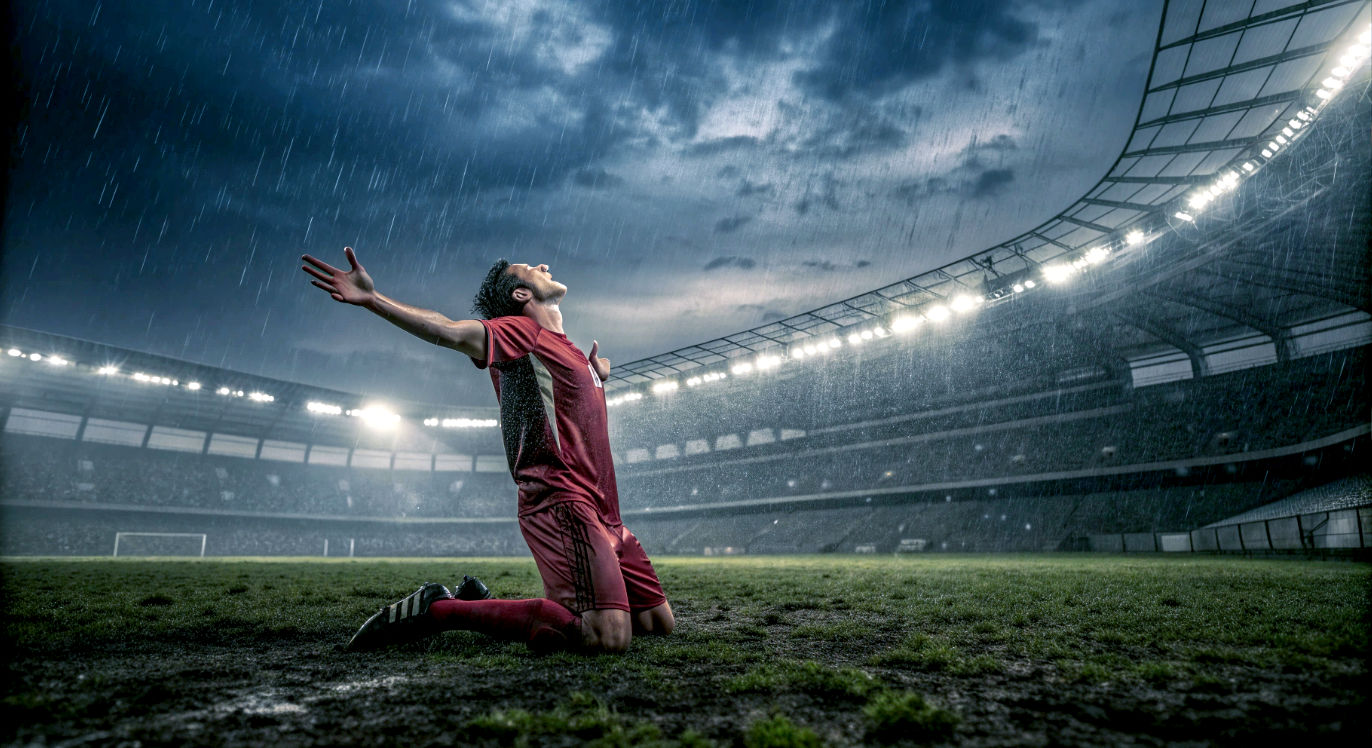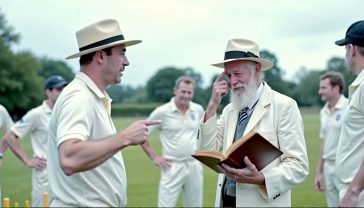Never Say Die: The Definitive Story of Sport’s 10 Greatest Comebacks
Explore the definitive stories behind sport’s most incredible turnarounds, from last-minute goals to career-defining moments of pure grit. A must-read for any fan.

This post may contain affiliate links. If you make a purchase through these links, we may earn a commission at no additional cost to you.
Sport, at its very best, isn’t just about winning or losing. It’s about the story. It’s about that moment when everything seems lost, when the clock is ticking down and defeat feels like a certainty. And then, something shifts. A flicker of hope, a spark of defiance, a roar from the crowd. It’s in these moments that legends are born.
We’re not just talking about a team snatching a late winner. We’re talking about the moments that defy logic. The ones that give you goosebumps just thinking about them. These are the stories of teams and individuals who looked defeat square in the eye and refused to blink. They’re tales of grit, belief, and that little bit of magic that makes sport so utterly captivating. From the roaring stadiums of English football to the sun-baked cricket pitches of Headingley, these are the comebacks that remind us why we love the game. They show us that no matter how bleak things look, it’s never, ever over until it’s over.
So, grab a brew and settle in. We’re about to relive ten of the most astonishing, heart-stopping, and truly greatest comebacks in the history of sport.
1. The Miracle of Istanbul (Football, 2005)
The Backstory: A Mountain to Climb
The 2005 UEFA Champions League Final in Istanbul was meant to be a coronation. On one side stood AC Milan, a team of superstars. Think Paolo Maldini, Cafu, Andriy Shevchenko, and Kaká—a proper footballing royal family. On the other was Liverpool, a team of grit and passion, but one that, on paper, simply didn’t compare.
For 45 minutes, the script went exactly as expected. Milan were sublime. They sliced through Liverpool with terrifying ease. Maldini scored in the first minute. Then Hernán Crespo bagged two more. By half-time, it was 3-0. The game wasn’t just over; it was a humiliation. Liverpool fans, who had travelled across Europe to be there, sat in stunned silence. The players trudged into the dressing room with their heads bowed, the dream in tatters.
The Moment: When Hope Fought Back
Nobody knows exactly what was said in that dressing room, but something changed. The team came out for the second half, and as their fans began a defiant, heartfelt chorus of “You’ll Never Walk Alone,” the impossible began to happen.
It started with the captain, Steven Gerrard. In the 54th minute, he launched himself at a John Arne Riise cross, heading the ball perfectly into the corner. 3-1. A glimmer of hope. Just two minutes later, Vladimír Šmicer tried his luck from distance. The shot wasn’t perfect, but it squirmed past Milan’s keeper, Dida. 3-2. The stadium erupted. Suddenly, the impossible felt possible.
The tidal wave of red shirts kept crashing forward. In the 60th minute, Gennaro Gattuso clumsily brought Gerrard down in the box. Penalty. Xabi Alonso stepped up. Dida saved it! But the ball looped back into the air, and Alonso was the first to react, smashing the rebound into the roof of thenet. 3-3. Three goals in six minutes. It was utter madness. The game eventually went to a penalty shootout, where Liverpool’s keeper, Jerzy Dudek, did his now-famous “spaghetti legs” dance to put off the Milan players. He saved two, Shevchenko missed the decisive kick, and Liverpool had won the European Cup.
The Legacy: More Than Just a Win
The Miracle of Istanbul isn’t just Liverpool’s greatest night; it’s one of football’s greatest stories. It’s a testament to the power of belief and the impact of a roaring crowd. For a generation of fans, it became the ultimate proof that you should never, ever give up. It cemented Steven Gerrard’s status as a legend and gave the sport a fairy tale that will be told for a hundred years.
2. Botham’s Ashes (Cricket, 1981)
The Backstory: A Mountain to Climb
The summer of 1981 was a grim one for English cricket. The Ashes were on the line, and Australia, led by the formidable Dennis Lillee and Terry Alderman, were running riot. After losing the first Test and drawing the second, England arrived at Headingley in Leeds for the third Test in complete disarray.
To make matters worse, their talismanic captain, Ian Botham, had been stripped of the captaincy. He was out of form and under pressure. England were bowled out for a miserable 174, and Australia replied with a massive 401. England were forced to “follow-on”—meaning they had to bat again immediately. They were so far behind, the bookies offered odds of 500-1 against an England win. It wasn’t a question of if Australia would win, but when. When England slumped to 135 for 7 in their second innings, still miles behind, some of the Australian players booked their hotels for the next match.
The Moment: When Hope Fought Back
Ian Botham walked out to bat with England on the brink of a humiliating defeat. With nothing left to lose, he decided to have some fun. He threw caution to the wind and started swinging. He smashed the ball to all corners of the ground in one of the most astonishing displays of hitting ever seen. His unbeaten 149 not out was an explosion of pure defiance. He was helped by a stubborn Graham Dilley and Chris Old, but this was Botham’s show.
His heroics set Australia a target of just 130 to win. It should have been a walk in the park. But Botham had lit a fire under his team. The fast bowler Bob Willis charged in, bowling like a man possessed. He took an incredible 8 wickets for 43 runs, tearing through the Australian batting line-up. Australia were all out for 111. England had won by 18 runs.
The Legacy: More Than Just a Win
This wasn’t just a cricket match; it was a national event. The “Miracle of Headingley” turned Ian Botham into a national hero and remains, for many, the greatest Test match ever played. It’s a story that transcends cricket, a perfect example of a single individual refusing to accept defeat and inspiring everyone around them to achieve the impossible. It completely turned the series on its head, with England going on to win The Ashes 3-1.
3. The Rumble in the Jungle (Boxing, 1974)
The Backstory: A Mountain to Climb
In 1974, George Foreman was the most feared man on the planet. He was the undefeated heavyweight champion of the world, a wrecking machine who had destroyed Joe Frazier and Ken Norton, two men who had previously beaten Muhammad Ali. Foreman was younger, stronger, and bigger than the 32-year-old Ali.
Ali, on the other hand, was seen as being past his prime. He’d been stripped of his title and exiled from boxing for three years for refusing to fight in the Vietnam War. Many thought he was taking on a fight he couldn’t possibly win. The bout was held in Kinshasa, Zaire (now the Democratic Republic of Congo), and the world expected to see Ali get knocked out.
The Moment: When Hope Fought Back
From the first bell, Ali did something nobody expected. Instead of his trademark “float like a butterfly, sting like a bee” style of dancing around the ring, he went straight to the ropes. He covered up, letting the fearsome Foreman punch himself out. Foreman threw haymaker after haymaker, but Ali absorbed them on his arms and body, leaning back on the loose ring ropes to take the sting out of the blows. He whispered in Foreman’s ear, “Is that all you got, George?”
This new tactic, which Ali later called the “rope-a-dope,” was incredibly risky. But it worked. Round after round, Foreman threw his biggest shots, getting more and more tired in the sweltering African heat. By the eighth round, he was exhausted. Ali saw his moment. He came off the ropes and unleashed a blistering combination of punches that sent the giant Foreman crashing to the canvas. The unbeatable champion was counted out.
The Legacy: More Than Just a Win
The Rumble in the Jungle was a masterpiece of strategy and courage. Ali didn’t just win a boxing match; he cemented his legend as “The Greatest.” He out-thought and out-willed a man who was physically superior in every way. It was a victory for intelligence over brute force and a defining moment of the 20th century, proving that Ali was not just a great athlete, but a true genius.
4. Tiger Woods’ Masters Triumph (Golf, 2019)
The Backstory: A Mountain to Climb
For over a decade, Tiger Woods wasn’t just a golfer; he was a phenomenon. He dominated the sport, winning 14 major championships and changing the game forever. But then, it all fell apart. A string of personal scandals was followed by years of crippling injuries. He had four back surgeries, including one that fused his spine. At one point, he could barely walk, let alone swing a golf club.
His career looked over. From being the world number one for a record 683 weeks, he plummeted to outside the top 1,000. The idea of him ever winning another tournament, let alone a major, seemed like a fantasy. His return to the sport was tentative, a shadow of his former self.
The Moment: When Hope Fought Back
By 2019, Tiger was playing better, but winning a major still felt like a step too far. He arrived at The Masters at Augusta National, the scene of his first major win, as an outsider. But as the week went on, something special started to happen. He was calm, focused, and his famous nerve seemed to be back.
He entered the final round two shots behind the leader, Francesco Molinari. While his rivals faltered under the intense Sunday pressure—finding the water on the infamous 12th hole—Tiger remained rock-solid. He played smart, patient golf, letting others make mistakes. He finally took the lead on the 15th hole and walked up the 18th fairway with a two-shot cushion. When he tapped in the final putt, the crowd’s roar was deafening. He let out a triumphant shout of his own, a release of years of pain and doubt, before hugging his children.
The Legacy: More Than Just a Win
This wasn’t just a golf victory; it was one of the greatest redemption stories in all of sport. It was a triumph of perseverance over unimaginable physical and mental pain. Eleven years after his last major win, and after everything he had been through, Tiger Woods was a major champion again. It was a moment that brought joy to millions around the world, whether they were golf fans or not.
5. Manchester United’s Last-Gasp Double (Football, 1999)
The Backstory: A Mountain to Climb
Sir Alex Ferguson’s Manchester United team were on the cusp of greatness in 1999. They had already won the Premier League and the FA Cup. Now, only the UEFA Champions League final stood between them and an unprecedented “Treble.” Their opponents were German giants Bayern Munich, a team known for its efficiency and mental strength.
The final, held in Barcelona’s Camp Nou stadium, started terribly for United. They went 1-0 down after just six minutes and, for the next 84 minutes, were thoroughly outplayed. Bayern hit the woodwork twice and looked far more likely to score a second than United did to find an equaliser. As the game entered injury time, United looked beaten. The famous trophy was already being decorated with Bayern Munich ribbons.
The Moment: When Hope Fought Back
The fourth official signalled three minutes of added time. It felt more like a countdown to United’s defeat than a window of opportunity. But this was a team that had a famous “never say die” spirit. They won a corner. With everyone, including goalkeeper Peter Schmeichel, pushed forward, David Beckham swung the ball in. It caused chaos in the box, and after a weak clearance, Ryan Giggs scuffed a shot that fell perfectly to Teddy Sheringham, who swept it into the net. 1-1!
United had salvaged extra time. Or so everyone thought. Straight from the kick-off, United surged forward again and won another corner. Beckham again delivered a perfect ball, Sheringham flicked it on, and fellow substitute Ole Gunnar Solskjær stuck out a foot to poke it into the roof of the net. 2-1! The stadium exploded. The Bayern players collapsed in disbelief. United had scored two goals in 102 seconds to snatch victory from the jaws of defeat.
The Legacy: More Than Just a Win
United’s victory in 1999 is the most dramatic finish to a final in football history. It immortalised Ferguson’s team and perfectly captured their relentless, attacking spirit. The phrase “football, bloody hell,” uttered by a stunned Ferguson afterwards, entered sporting folklore. For United fans, it remains the crowning glory of their club’s history.
6. The Black Ball Final (Snooker, 1985)
The Backstory: A Mountain to Climb
In the 1980s, Steve Davis was the undisputed king of snooker. He was the world number one, a winning machine who played with an almost robotic precision. His opponent in the 1985 World Championship final was Dennis Taylor, a cheerful Northern Irishman known for his quirky, oversized glasses. Nobody gave Taylor a chance.
The final was a rout from the start. Davis stormed into an 8-0 lead. It was embarrassing. Taylor looked completely outclassed. The match was scheduled to last for a maximum of 35 frames, and it looked like Davis would wrap it up with a day to spare.
The Moment: When Hope Fought Back
Instead of crumbling, Taylor dug in. Frame by frame, he clawed his way back into the match. He fought for every ball, refusing to give in. By the end of the final day, he had done the unthinkable: he’d drawn level at 17-17. The world championship would be decided on a single, final frame.
The frame lasted an epic 68 minutes. It came down to the very last ball—the black. The tension was unbearable. A staggering 18.5 million people were watching on the BBC, well after midnight. Davis had the first chance but overcut it, leaving it hanging over the pocket. Taylor, after a couple of nervy attempts, finally lined up the shot of his life. He stroked it in, raised his cue above his head, and wagged his finger in a celebration of pure, unadulterated joy.
The Legacy: More Than Just a Win
This match is, without doubt, the most famous in snooker history. It made Dennis Taylor a household name and turned a whole generation of Brits into snooker fans. It was the ultimate underdog story: the likeable joker toppling the unbeatable champion in the most dramatic way imaginable.
7. The Miracle at Medinah (Golf, 2012)
The Backstory: A Mountain to Climb
The Ryder Cup, a biennial golf match between Europe and the USA, is known for its passionate crowds and intense pressure. In 2012, at the Medinah Country Club near Chicago, Team Europe were getting hammered. Going into the final day’s singles matches, they trailed the USA 10-6.
To win, they needed to win 8 of the 12 singles matches on American soil, against a rampant home team, roared on by a ferociously partisan crowd. It had only ever been done once before in the history of the event. The American team were already celebrating. It looked completely hopeless.
The Moment: When Hope Fought Back
The European captain, José María Olazábal, sent his best players out first to try and build some momentum. The charge was led by England’s Ian Poulter, a man who seems to transform into a golfing superhero at the Ryder Cup. Poulter’s passionate, fist-pumping performance was infectious. Luke Donald, Paul Lawrie, and Rory McIlroy all secured early wins. Suddenly, the scoreboard began to turn blue, the colour of Team Europe.
The belief spread through the team. Justin Rose sank a monster putt on the 17th hole to win a crucial match. Germany’s Martin Kaymer, who had struggled for form, found himself facing the final, decisive putt on the 18th green. He calmly rolled it in, completing the most astonishing turnaround in Ryder Cup history. Europe had won 14.5-13.5.
The Legacy: More Than Just a Win
The Miracle at Medinah was a triumph of team spirit and belief. The European team had been inspired by the memory of the legendary Spanish golfer Seve Ballesteros, who had recently passed away. They wore his signature navy and white colours on the final day. It was a victory that was about more than just golf; it was about friendship, passion, and honouring a hero.
8. New England Patriots’ Super Bowl Stunner (American Football, 2017)
The Backstory: A Mountain to Climb
Super Bowl LI was meant to be a passing of the torch. The Atlanta Falcons, with their explosive, high-scoring offence, were tearing the New England Patriots apart. Late in the third quarter, the Falcons led 28-3. In American football, that is a colossal, insurmountable lead.
The Patriots, led by legendary quarterback Tom Brady, looked old and slow. Brady had been harassed all game, and the Falcons’ fans were already celebrating their first-ever Super Bowl victory. The win probability for the Falcons at one point was over 99%.
The Moment: When Hope Fought Back
With their backs against the wall, Brady began to do what he does best: stay calm under pressure. He started picking the Falcons’ defence apart with short, methodical passes. A touchdown here, a field goal there. The lead started to shrink. With just under a minute left, the Patriots scored another touchdown and converted a two-point conversion to tie the game at 28-28, sending the Super Bowl to overtime for the first time in its history.
By now, the momentum had completely shifted. The Patriots won the coin toss in overtime and, with a sense of grim inevitability, Brady marched his team down the field. A final touchdown run sealed the deal. The Patriots had completed the biggest comeback in Super Bowl history.
The Legacy: More Than Just a Win
This game cemented Tom Brady’s reputation as the greatest quarterback of all time. It was a masterclass in composure and clinical execution under extreme pressure. For the Atlanta Falcons and their fans, it was a sporting trauma from which they have arguably never fully recovered. It’s a brutal reminder that in sport, you can never celebrate too early.
9. Greg LeMond’s Tour de France Ride (Cycling, 1989)
The Backstory: A Mountain to Climb
In 1987, American cyclist Greg LeMond was on top of the world. He had won the Tour de France the previous year. Then, his life changed forever during a hunting trip when he was accidentally shot by his brother-in-law. With over 60 lead pellets lodged in his body, including some in the lining of his heart, he was lucky to be alive. His cycling career seemed certain to be over.
He spent two years in a painful recovery, but he was determined to race again. He returned to the 1989 Tour de France, but he was not considered a contender. He was riding for a new, small team and was still suffering from the effects of his injuries.
The Moment: When Hope Fought Back
Against all odds, LeMond found himself locked in a titanic battle for the famous yellow jersey with the brilliant French rider, Laurent Fignon. Going into the final stage, a short time trial into the centre of Paris, LeMond was 50 seconds behind Fignon.
Nobody had ever overturned such a large deficit on the final day. To make things even harder, Fignon was one of the best time trialists in the world. But LeMond had a secret weapon: new, aerodynamic handlebars that allowed him to get into a much lower, faster position on the bike. As Fignon rode with his ponytail blowing in the wind, LeMond, wearing an aerodynamic helmet, sliced through the air. He rode the race of his life, beating Fignon by 58 seconds to win the entire Tour de France by just eight seconds—the smallest margin in the race’s history.
The Legacy: More Than Just a Win
LeMond’s 1989 victory is one of the most emotional and inspiring stories in cycling. It was a triumph of human resilience and innovation. To come back from a near-fatal accident to win sport’s most gruelling endurance event in such a dramatic fashion is the stuff of Hollywood movies.
10. Sir Steve Redgrave’s Fifth Gold (Rowing, 2000)
The Backstory: A Mountain to Climb
This isn’t a comeback from a single moment of defeat, but a career-long comeback against the odds of time, age, and illness. After winning his fourth consecutive Olympic gold medal in Atlanta in 1996, rower Sir Steve Redgrave famously said, “If anyone finds me going near a boat again, they have my permission to shoot me.” He was exhausted, physically and mentally.
But the lure of a historic fifth gold was too strong. He decided to continue for another four years to the Sydney Olympics in 2000. However, his journey was far from smooth. In 1997, he was diagnosed with Type 2 diabetes. He was also suffering from ulcerative colitis. At an age when most rowers have long since retired, he was battling chronic illness while trying to compete at an elite level.
The Moment: When Hope Fought Back
Redgrave formed a coxless four team with Matthew Pinsent, Tim Foster, and James Cracknell. They were a formidable crew, but the pressure in Sydney was immense. The final was a brutal, gut-wrenching race. The British boat took an early lead, but the Italian crew pushed them all the way to the line.
For two agonising kilometres, they held off the challenge. They crossed the line first by less than half a second. Redgrave slumped forward, utterly spent. He had done it. Five gold medals at five consecutive Olympic Games.
The Legacy: More Than Just a Win
Sir Steve Redgrave’s achievement makes him, for many, Britain’s greatest ever Olympian. His story is one of incredible longevity and mental fortitude. It wasn’t just about winning; it was about his refusal to be beaten by age, by exhaustion, or by debilitating illness. It redefined what was possible for an endurance athlete and inspired a generation of British sports stars.
Further Reading
For those who wish to delve deeper into these incredible stories, here are some highly respected resources:
- BBC Sport: https://www.bbc.co.uk/sport – For detailed reports, archives, and documentaries on many of these events.
- The Guardian Sport: https://www.theguardian.com/uk/sport – Known for its excellent long-read articles and in-depth sports journalism.
- ESPN: https://www.espn.co.uk/ – Offers comprehensive coverage and historical features on global sporting events.
- Sports Illustrated: https://www.si.com – A source of classic sports writing and iconic photography.






